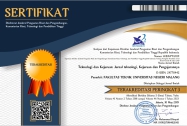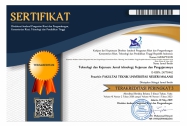The Influence of Character Building, Learning Environment and Self Efficacy on Students' Work Readiness
Abstract
Students' readiness to work was considered essential for because the more interest that individuals have, in this case, are students; the higher their work readiness in their efforts to achieve the desired goals. This study aimed to determine the effects, both partially and simultaneously, of character-building variables, learning environment, and self-efficacy on work readiness. This research was descriptive quantitative research. The population in this study was the twelve grade students of Automotive Lightweight Vehicle Engineering at Public Vocational High School 1 Trenggalek with a total of 143 students, and the samples were 107 students that were chosen using the proportional random sampling technique. The instruments in this study were questionnaires and documentation. The analysis of research data used descriptive statistical analysis, multiple linear regression analysis, classic assumption test, which included normality test, multicollinearity test and heteroscedasticity test. The hypothesis testing included t-test and f-test, determination coefficient (R2) and significant contribution. Based on the data analysis, the results showed that there was partially and simultaneously significant influence of character building variables, learning environment and self-efficacy on work readiness of the twelve grade students of Automotive Lightweight Vehicle Engineering at Public Vocational High School 1 Trenggalek.
Keywords
Full Text:
PDFReferences
Owusu-Agyeman, Y., & Fourie-Malherbe, M. (2019). Workforce development and higher education in Ghana: A symmetrical relationship between industry and higher education institutions. Industry and Higher Education, 33(6), 425-438. doi: 10.1177/0950422219875000. Wu, W. Y., Weng, K. H., Wen, M. H., You, B. J., & Lian, J. W. (2017, November). The Construction of Web- Learning System and Learning Performance Based on Online Interaction and Self-Regulation Theories- Architectural Design Curriculum. In 2017 International Conference on Information, Communication and Engineering (ICICE) (pp. 288-291). IEEE. doi: 10.1109/ICICE.2017.8479001. BPS. (2019). Tingkat Pengangguran Terbuka (TPT) sebesar 5,01 persen. Jakarta: BPS. Phillips, B. N., Turnbull, B. J., & He, F. X. (2015). Assessing readiness for self-directed learning within a non- traditional nursing cohort. Nurse Education Today, 35(3), e1-e7. doi: 10.1016/j.nedt.2014.12.003. Knoll, S. W., & Horton, G. (2015, January). The Impact of Analogical Distance as a Mental Stimulus in Ideation Processes Using Change of Perspective: Jumping. In 2015 48th Hawaii International Conference on System Sciences (pp. 226-235). IEEE. doi: 10.1109/HICSS.2015.36. Rivizzigno, A. S., Brendgen, M., Feng, B., Vitaro, F., Dionne, G., Tremblay, R. E., & Boivin, M. (2014). Gene– environment interplay between number of friends and prosocial leadership behavior in children. Merrill- Palmer Quarterly (1982-), 60(2), 110-141. doi: 10.13110/merrpalmquar1982.60.2.0110. Towle, E., Mann, J., Kinsey, B., O'Brien, E. J., Bauer, C. F., & Champoux, R. (2005, October). Assessing the self-efficacy and spatial ability of engineering students from multiple disciplines. In Proceedings Frontiers in Education 35th Annual Conference (pp. S2C-15). IEEE. doi: 10.1109/fie.2005.1612216. Gunawan, I., Kusumaningrum, D. E., Triwiyanto, T., Zulkarnain, W., Nurabadi, A., Sanutra, M. F. A., ... & Yuantika, E. A. F. (2018, October). Hidden Curriculum and Character Building on Self-Motivation based on K-means Clustering. In 2018 4th International Conference on Education and Technology (ICET) (pp. 32-35). IEEE. doi: 10.1109/ICEAT.2018.8693931. Eilam, E., & Trop, T. (2014). Factors influencing adults’ environmental attitudes and behaviors and the role of environmental schools in influencing their communities. Education and Urban Society, 46(2), 234-263. [Harjali, H. (2017). Strategi guru dalam membangun lingkungan belajar yang kondusif: studi fenomenologi pada kelas-kelas sekolah menengah pertama di Ponorogo. Jurnal Pendidikan dan Pembelajaran (JPP), 23(1), 010-019. Zulkosky, K. (2009, April). Self‐efficacy: a concept analysis. In Nursing forum (Vol. 44, No. 2, pp. 93-102). Malden, USA: Blackwell Publishing Inc.
DOI: http://dx.doi.org/10.17977/um031v43i12020p67-74
Refbacks
- There are currently no refbacks.
Copyright (c) 2020 Teknologi dan Kejuruan: Jurnal Teknologi, Kejuruan, dan Pengajarannya
Teknologi dan Kejuruan: Jurnal Teknologi, Kejuruan, dan Pengajarannya
E-ISSN 2477-0442 (online)
Contact
Faculty of Engineering, Universitas Negeri Malang (UM)
Jl. Semarang No 5 Malang 65145, Building H5, 1st Floor.
Homepage: http://journal2.um.ac.id/index.php/teknologi-kejuruan
Email: teknologikejuruan.ft@um.ac.id

This work is licensed under a Creative Commons Attribution 4.0 International License.



2.png)
1.png)
1.png)
1.png)
4.png)
1.png)
.png)

3.png)
1.png)
1.png)


